What if I told you about an extremely underutilized movement that could improve your overall mobility, strength, and posture? One thing that, once added to your training regimen (or life in general), could remedy aches and pains, accelerate your recovery, regain lost straight-arm range and strength, and provide a powerful full-body antidote to gravity. Curious yet?
It’s also a minimalist move that you can do virtually anywhere and anytime with minimal equipment, that benefits your back, grip, elbows, shoulders, and midsection. Something so deceptively simple it gets overlooked or dismissed by the masses.
That move would be hanging.
I bet that most remember hours of childhood monkey bar fun (or fence and tree branch fun), hanging from our hands, heads-or-bottoms-up, swinging from arm to arm (brachiating), flipping, leg-raising, and whatever else we could come up with to impress our friends. Hanging was just active fun—untainted by the notion of organized exercise—that just so happened to deliver benefits that we never thought to care about.
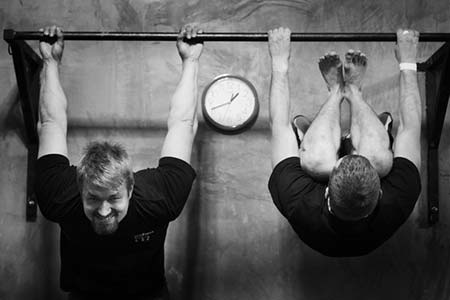
The Benefits of Hanging Exercises
Doing full justice to all the benefits of hanging exercises in one article is difficult. But, for the sake of simplicity, consider that they:
- decompress the spine
- stretch the lats
- open the shoulders
- strengthen scapular stabilizers, rotator cuff, and shoulder muscles
- improve and strengthen straight-arm and overhead positions
- develop grip and forearm strength and endurance
- fortify your midsection
Hanging is one of the keys to healthy shoulders. Dr. John M. Kirsch writes in his book Shoulder Pain? The Solution and Prevention (2014):
“If you want to be able to use your arm for overhead activity, you must use the arm for overhead activity! You must use the shoulder for what it was designed to do: brachiate! Or at least simulate brachiating, by hanging from a bar and doing light weight lifting.”
The study done by the Kirsch Institute, presented in 2012, included 92 subjects, the majority of them:
“…had been suffering with shoulder pain for many years and had tried other methods of treatment at great expense with no relief. Most of these subjects were scheduled for or advised to have shoulder surgery… Of these 92 subjects, 90 were returned to comfortable DL (activities of daily living).”
Dr. Kirsch’s message is simple: “hanging from a bar and light weightlifting relieves most shoulder problems.”
The benefits are so numerous it makes you wonder why—outside of calisthenic specialists—hanging got lost in the cracks of mainstream exercise programs. But not in StrongFirst RESILIENT, where our Hanging Series builds on the support many old-timers and modern experts have for hanging.
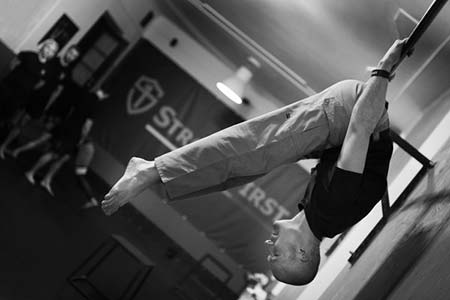
Pavel has emphasized the importance of spinal decompression (see Relax Into Stretch and Super Joints) and why it used to be a popular drill in strength culture both in the East and West, and should be again today.
Listen to Bob Hoffman of York Barbell:
“For many years the champion lifters of the York team have performed certain movements to keep their backs in good condition. Hanging is one of these, for hanging has a tendency to stop congestion by freeing the parts of the body from pressure of any sorts. Age manifests itself when the body settles upon itself, so the longer you can prevent this condition by standing and sitting erect, by exercising, thus keeping the muscles alive, elastic, and by the practice of at least a moderate amount of hanging the longer you will feel, act and look young.”—Bob Hoffman, The Lower Back, Part II, in Strength and Health, November 1957.
Hanging Out: An Introduction
Active and Passive Hang
Start with a shoulder-width pullup grip (palms away), with your thumbs wrapped around the bar.
Relax the whole body—let the elbows straighten, shoulders shrug, relax the ribcage and spine, let your legs hang loose. Release all tension, let gravity do its job.
Repeat using a chin-up grip (palms towards you). And finally, if you have the equipment (special pullup bar or gymnastic rings), repeat using a neutral grip (palms facing each other).
Note: If you have a weak grip or a previous shoulder/elbow injury or are overweight, start with an assisted hang with your feet on a box, chair, bench, etc. In this case, it is also advisable to begin with an active hang. As a general rule:
“If shoulder not stable—use active hangs. If stable—passive.”—Ido Portal
Heel Reach Spinal Decompression
Decompress the spine even more:
“While hanging, try to stretch down with your heels. Note that this has a completely different effect than pointing your toes down. The heels down is the proper way of getting a good stretch in your spine.”—Tommy Kono
“…decompressing the spine by hanging from a pull-up bar… will allow the disks to absorb more moisture. It will not only help you reclaim your youthful height but will do a lot for your spinal health and mobility.”—Relax into Stretch
Add Contrast Breathing
“Inhale maximally and tighten up your entire body… hold your breath—and tension—for a second or so, then suddenly let it all out with a sigh of relief… During the inhalation, make sure not to pull yourself up—which will reduce the amount of stretch.”—Relax into Stretch
Add Leg and Torso Movements
Increasing the ROM by prying—add leg and torso movement: side to side, left and right, back and forth (chest out, chest in). Keep the elbows straight. Don’t go fast.
“In a free hang, Tartakovsky advises various leg and torso movements to amplify the effect: moving the legs back and forth and side to side, together and separate; non-ballistic turns of the torso with the feet held together.”—Super Joints
Get Down Safely
Any time you do any type of relaxed hanging, brace your abs first and hold it for few seconds before you jump off the bar. Or even better, listen to Kono:
“In releasing yourself from the chinning bar, avoid jumping down. Instead, have a chair or something to step on to get down. The act of jumping down would be a compressive movement, so avoid it if possible. A ‘gentle’ release from the hanging position is best.”
Equipment
Listen to Ido Portal, one of today’s main proponents of hanging and brachiation drills, whose “Hanging Month” has featured many useful tips and techniques:
“Rings are more accommodating for alignment but are less stable. They are a better fit for a strong and inflexible pair of shoulders. They are also a better fit for anyone with wrist/elbow issues. The bar is less accommodating but sturdier—it is a better fit for mobile but weaker shoulders. If you have both optimal range of motion and strength—vary the types of anchors you use as much as possible—bar, parallel bars, slanted bars, rings, ropes, towel, top of a wall, climbing grips, etc.”
Hanging Program
Roger Nelsen summaries the most important points on Dave Draper’s forum:
- Do something involving hanging from a bar every session
- Perform all pulls from a dead hang position
- Switch up your pulling exercises constantly, but focus on progression in each
- Don’t limit yourself to bent-arm pulling work, also work on straight-arm pulls (like levers, cross pulls, toes-to-bar, ‘skin the cat’, etc.)
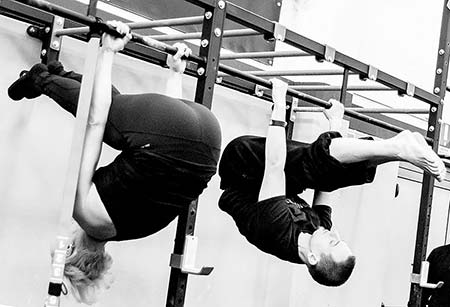
“All in all, most people just don’t spend enough time hanging from their hands, and they’d be a lot healthier and stronger if they did.”—Roger Nelsen
And from our perspective:
- Aim for ‘sets’ of 30 seconds plus
- Spread the hanging throughout the whole day. Grease the groove (GTG) works best—install a pullup bar or gymnastic rings in your office or home
- Get resilient—StrongFirst RESILIENT!
“Make sure to hang out after lifting weights. A set of hangs after every set of deadlifts makes a healthy addition to the ‘Power to the People!’ strength program.”—Super Joints
StrongFirst RESILIENT Hanging Series
The above was only a few of the simplest intro drills. The full StrongFirst RESILIENT Hanging Series—a straight-arm hanging counterpart to our supportive straight-arm Get-up Series—focusses on various types of hangs with step-by-step progressions: passive, active and dynamic; two-arm and single-arm; shoulder flexion and extension.
- Passive Hang
- Contrast Breathing
- Leg and Torso Movement
- Active Hang
- (Partial) Hollow Active Hang
- Arching Active Hang
- Side to Side Swing with (partial) Hand Release
- Back and Forth Swing
- One Arm Passive and Active Hang
- Inverted Tuck
- German Hang
- ‘Skin the Cat’
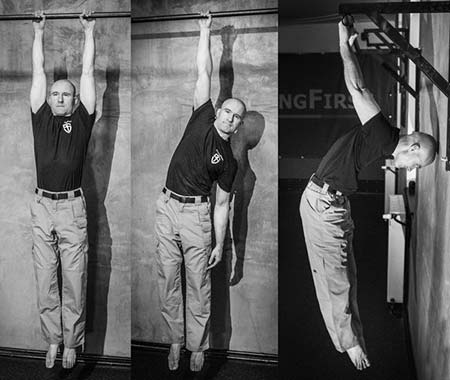
How to Progress your Hanging?
Once you have the hang of hanging (pun intended), you can set your sights towards countless progressions: pullups, chin-ups, hanging leg raises, front levers (covered in great detail in the StrongFirst SFB Bodyweight program), back levers, brachiation (“move by using the arms to swing from branch to branch”), muscle-ups, rock climbing, and tree climbing.
Gray Cook in the Essentials of Coaching and Training Functional Continuums DVD:
“You were on the monkey bar for months before you ever thought of pulling yourself above it. Why don’t we do that? If the carries make sense, why don’t hangs make sense? Why doesn’t the brachiation make sense? It should.
Maybe the limiting factor in your pull-ups isn’t your lats, but your ability just to handle that hang. I’m not saying your grip is weak. I’m saying you can’t handle hanging there, says Cook, and recommends to “triple your hang time flexed and triple your time extended” to improve your pull-ups.”
Forget the “exercise” for a moment and let your inner child play, knowing you’ve got the resilience to enjoy it.
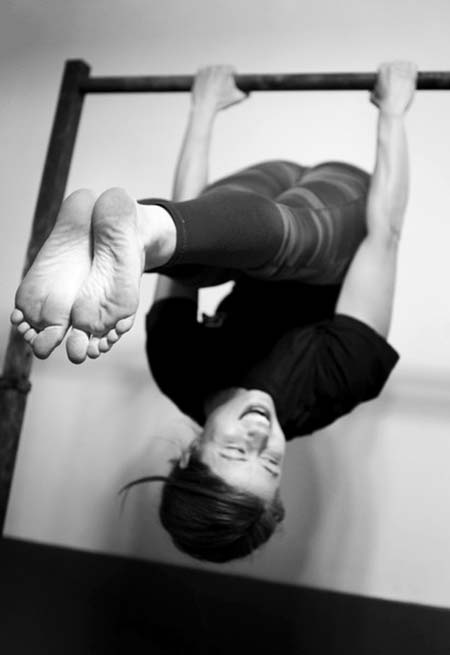
Let’s leave the last word to the International Weightlifting Federation’s ‘Lifter of the Century’—the great Tommy Kono:
“…’hanging’ is completely the opposite of what you are about to do when you start lifting weights overhead, compressing and taxing these various ‘joints’… The few minutes spent on doing these exercises will more than pay off in recuperative value and the feeling of well-being afterwards.”—Tommy Kono, Weightlifting, Olympic Style, Honolulu 2009.
StrongFirst RESILIENT Events
The StrongFirst RESILIENT seminar distills Pavel Tsatsouline’s bevy of innovative drills into a comprehensive system that will develop your ‘in between’ strength.
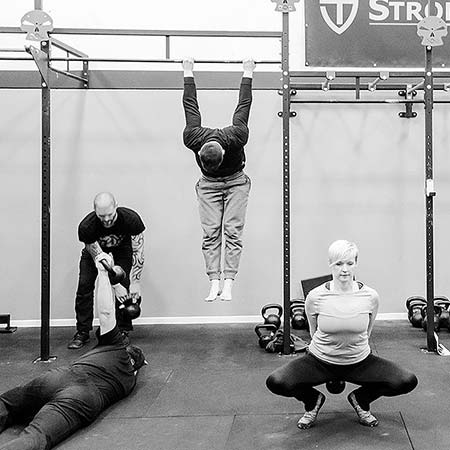
To be the first to know when new events are announced, as well as receive free video tips and articles, sign up for our weekly newsletter.
Images: Justyna K. Macková, StrongFirst Certified Team Leader, StrongFirst Elite; DLAB Photography and Visual Arts
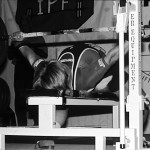
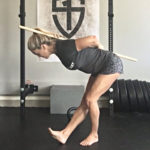
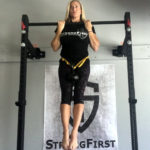







Pavel-
I really enjoyed this article.
I tried hanging. I had my toes lightly on the floor he entire time, braced my abs and slowly re-loaded to the ground. When finished though I had a pretty sharp pain immediately in my lower back on one side. Can you offer an idea of what happened here?
Blake, hard to say, question for your doc. Make sure to breath in, and brace, and preferably step off to a box, or bench, instead of jumping down.
Pavel, I’ve always hung from bars using a “thumbless” grip. Does it matter much either way?
Chris, as mentioned in the article, variation is the key: thumb/thumbless grip, over/under/hammer grip, pullup bar, rings…
Good article!
Out of curiosity…
“If shoulder not stable—use active hangs. If stable—passive.”
What qualifies as ‘not stable’ / ‘ stable’ ?
Thank you brother.
Unstable shoulders – previous sublux, shoulder tends to slip or feels unstable with certain activities, etc. From my experience, usually hypermobile and/or weaker students.
Important sentence, describing the StrongFirst RESILIENT Hanging Series, is: “a straight-arm hanging counterpart to our supportive straight-arm get-up series”.
What is a good goal for general fitness people to dead arm hang for an extended period of time?
Please see the following in the body of the article above:
“Aim for ‘sets’ of 30 seconds plus”
“Spread the hanging throughout the whole day. Grease the groove (GTG) works best—install a pull-up bar or gymnastic rings in your office or home”
“Get resilient—StrongFirst RESILIENT!”
I saw that 30 second benchmark but I can already hang for 90 seconds and wanted to know if there was a multi-tiered scale to strive for?
It sounds like you’re doing fine already. Benchmarks abound – I’ve seen people recommend a 2-minute hang, so you could try to work up to that (or perhaps you can do that already).
Another thing to try, which has been discussed on our forum and elsewhere, is hanging with pullups, 1 pullup every 10 or 15 seconds or so. This is a good assistance exercise for increasing bodyweight reps as I understand it, but only for someone who can already do a good amount of pullups.
Patrick, what Steve said.
I will add: Progress to one-arm hangs – first active, then passive.
Great article! Thank you!
I was curious about how much you’d suggest the shoulders be packed during hangs. I’ve heard concerns that completely relaxing the shoulder can cause issues. How do we go about that?
I would follow the general advice mentioned in the article: ““If shoulder not stable—use active hangs. If stable—passive.” When in doubt, please ask your Doc.
General Quote from the StrongFirst RESILIENT Manual:
“StrongFirst RESILIENT is focused on going beyond the conventional ‘correct’ technique. We will enter the dangerous zone—but carefully, step-by-step, and with a clear objective and purpose. Get ready for some gains from orderly disorder.”
“The exercises that we are going to present will improve your range of motion, strengthen your current ROM and weak links, and lower the risk of potential injury, by so called ‘imperfection training,’ develop the ‘in between’ strength and improve your quality of moving well and moving strong outside the lifting gym environment: in your sport game—or the real life out there.”
Awesome content!! I guess that’s a positive way that we should behave like monkeys sometimes
Thank you, I am glad you like the article.
I agree 100%. Super important for judo and similar sports where you are gripping all the time in all sorts of ways. I have gymnastics rings on my chinup bar which makes some of these exercises more accessible. There is a lot we can do just by holding a position keeping us under tension. I also use the paralell bars for the same kind of tension-holding exercises like L,N and V sits. I’m working towards being able to do a tuck planche also. On the bar someday I’d love to do levers. Someday…
Recommendation – SFB Bodyweight Certification. You will learn lots of tension skills and secrets, that you can apply to any type of strength training, as well as other athletic endeavors.
Yes, I want to get it and the kettlebell one too. I can pass the one arm one leg pushup already, got a video of me doing it years ago. The pistol squat I’ll have to work up to. The 5 pullups though is also no problem.
You will love it. For combat athletes/”Naked Warriors” – gold.
I’ve been doing a lot of these hanging exercises after reading the article. My basic position is the inverted tuck planche which is sort of a bodyweight deadlift kind of a position I guess! From there I experiment with tuck or partial normal planches, leg raises, pullups etc. On my rings I do skin the cats and straight legs pointed up to the ceiling upside down hangs and again experiment with exact positioning. This all seems to be a very convenient way to get a lot of good stuff done for strength, mobility and well-being.
This might be the single most impactful SF article for me so far. Thank you.
I am very glad to hear that, thank you for your kind words.
Great article, and well documented. It reminds me that I should probably practice those more often.
Thank you brother. Yes, please do – simple, but very powerful addition to your regular training.